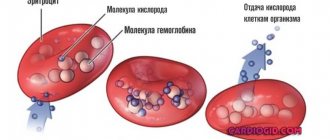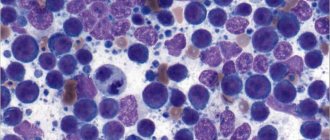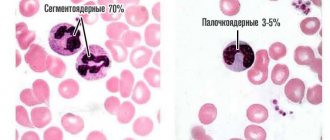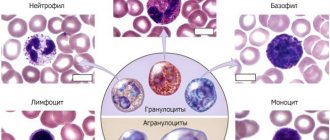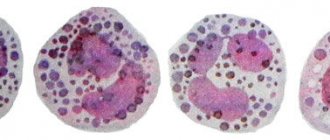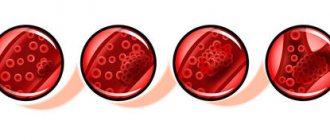Lymphocytes - what are they, what are they?
Lymphocytes are one of the components of white blood cells; a complete blood test for lymphocytes . They play an important role in the formation of immune responses. Their function is to recognize pathogens and mutated own cells. After identifying a foreign object, lymphocytes destroy it in one way or another: phagocytosis, production of special antigens. To destroy their own cells that have degenerated into cancer or have undergone other changes, lymphocytes send a special chemical signal that causes such a cell to start the process of self-destruction. In addition to a general blood test for lymphocytes, a biochemical blood test is performed at the MedArt Medical Center.
There are three types of these cells:
- T lymphocytes. They mature in the thymus. They play an important role in the fight against foreign bodies and infections. Some T-lymphocytes perform regulatory functions and are responsible for the duration and strength of the immune response. It is these cells that are affected when infected with HIV.
- B lymphocytes. Their main task is to produce antibodies against viruses and other infectious agents. In addition, they are able to retain information about past diseases, thereby creating permanent immunity.
- NK – cells. Their main function is to detect and eliminate body cells that have degenerated into malignant ones.
Lymphocytes are formed in the red bone marrow; their young, immature forms are called lymphoblasts. Maturation occurs in several stages, occurring not only in the bone marrow, but also in the lymphoid nodes and other organs of the lymphatic system.
The appearance of an increased number of lymphocytes can serve as a marker of bone marrow pathologies and the development of tumor processes in it. An increase in the level of lymphoblasts is also recorded during prolonged infectious processes. In this case, this serves as a sign of depletion of the body's defenses. The immune system does not have time to prepare a sufficient number of lymphocytes to fight the pathogen, and this becomes the reason for the appearance of a large number of lymphoblasts in the blood.
Diagnostics
The level of lymphocytes is measured during a clinical blood test. Due to the fact that lymphocytosis has a fairly wide etiological spectrum, if it is detected, you should contact a generalist (general practitioner or pediatrician) so that, based on the patient’s complaints, anamnestic data, and physical examination, he will prescribe an additional examination, which may include:
- Blood tests
. The leukocyte formula is calculated to determine the percentage of all forms of leukocytes. A blood smear is studied using microscopy to identify atypical mononuclear cells, Botkin-Gumprecht shadows (remnants of destroyed lymphocytes). Inflammatory markers are determined - increased ESR, CRP. To detect tumor antigens, immunophenotyping and immunohistochemical studies are performed. - Pathogen identification
. In order to identify an infectious agent, tests are performed for the presence of antibodies to pathogens and their DNA (by ELISA, PCR). Bacteriological studies are carried out - culture, sputum microscopy (tuberculosis, whooping cough), serological diagnostics - Wright, Heddelson reaction (brucellosis), microprecipitation reaction (syphilis). - Instrumental Research
. With tuberculosis, an X-ray of the lungs shows an increase in the hilar and mediastinal lymph nodes, infiltration of the upper lobes of the lungs, and sometimes effusion into the pleural cavity. In case of mononucleosis and hemoblastoses, ultrasound of the abdominal cavity reveals pronounced splenomegaly, less often hepatomegaly. - Histological studies
. In chronic lymphocytic leukemia, a large number of lymphoblasts are found in the bone marrow punctate. In lymphomas, a lymph node biopsy obtained by fine-needle aspiration reveals diffuse proliferation of lymphoid cells with blast morphology. A specific sign of lymphogranulomatosis is Berezovsky-Sternberg giant cells.
Leukocyte count
Indications for analysis
A general blood test for lymphocytes is prescribed if there is a suspicion of an increase or decrease in their number. The analysis can be prescribed for other reasons; it allows you to obtain a lot of valuable data about the state of the blood and the whole body. The main indications include:
- Detection of the immune response to the presence of pathogenic microorganisms.
- The state of human immunity.
- Physical and chemical composition of blood.
- Preventive analysis - to detect hidden changes in the blood formula that do not manifest themselves with specific symptoms.
Functions
Various bacteria, coccal infections, viruses, and fungi are considered “foreign”. Equally important is the attitude towards the body’s own mutated cells. Lymphocytes consider all other cells of organs and tissues to be their own and are related to them. Tumor cells that are aged or damaged are considered foreign.
All “management” of immunity is distributed among lymphocytes according to functions:
- identification of a “stranger” by reconnaissance cells;
- recognition according to the type “friend - stranger” and “familiar - unfamiliar”;
- organization of attack, attack and destruction;
- remembering information about “enemies” and passing it on to next generations.
Preparing for analysis
The analysis for lymphocytes is included in the general blood test, the rules for their conduct are the same. That is, such an examination does not require special preparation. There are only two conditions that must be met:
- Blood is taken in the morning.
- 8-12 hours before blood sampling you need to abstain from food.
You should also not smoke 2-3 hours before the procedure. Components of tobacco smoke can cause serious temporary changes in white blood cell levels. You should avoid drinking alcohol 2-3 days before taking the test, as alcohol can also affect the reliability of the results obtained.
If these requirements are not met, the accuracy of the examination may deteriorate, which will lead to the doctor receiving unreliable information and possible errors in diagnosis or re-prescribing the examination.
Other factors
Among the causative mechanisms of increased blood lymphocytes, one can note various internal and external factors, which are very rare, but can act as a cause of lymphocytosis. It can be:
- Hyperthyroidism (increased thyroid function);
- Addison's disease (decreased adrenal function);
- Treatment with hematopoietic stimulants;
- Vaccination against common infections of a child or adult;
- Hepatomegaly and hepersplenism (enlargement of the spleen with increased function). This results in more lymphocyte cells being released into the blood.
Video about the types and functions of leukocytes:
Research method
Material for analysis of lymphocytes is collected from a vein using a conventional syringe or a special vacuum system. The traditional technique of taking an analysis using a conventional syringe is currently outdated and can lead to the following difficulties:
- Blood clotting in a needle.
- Destruction of some blood cells.
- Long manipulation time.
- Contact of blood with the environment
- It is difficult to maintain the correct ratio of blood and reagents. In addition, the traditional technique does not exclude contact of medical personnel with the patient’s biomaterial, which can pose a health hazard. Therefore, many clinics use modern vacuum containers for blood collection.
Blood enters it due to the vacuum in the test tube; all parameters of the vacutainer are selected at the production stage in order to reduce the time for blood collection and ensure the correct ratio of the amount of reagent and blood.
Advantages of vacuum systems:
- A standardized blood collection process that takes minimal time.
- Contact of medical staff with the patient’s blood is completely excluded.
- Simple labeling and identification of samples, eliminating confusion with tubes.
- Almost painless procedure.
You can take blood for a general analysis from a finger, but at the moment this procedure is used much less frequently.
Red blood cells
Erythrocytes, or red blood cells, ensure the delivery of oxygen to all cells of the body. In English-language literature, red blood cells are called “red blood cells,” which is where the international abbreviation RBC .
To transport oxygen, these cells contain hemoglobin, which can combine with it through chemical reactions. The analyzer displays the following indicators regarding these processes:
- RBC is the number of red blood cells per liter of blood. An increase in this indicator in humans can be observed with various neoplasms, hormonal disorders, but much more often it is the result of blood thickening due to dehydration, burns, taking diuretics and some other reasons. A decrease in RBC is observed with blood loss, anemia, disorders of their formation or increased destruction. A slight decrease in the number of red blood cells during pregnancy is normal.
- HGB - total hemoglobin content. The indicator grows following an increase in RBC and decreases for the same reasons. A decrease in HGB is also observed during hemodilution—blood dilution, for example, against the background of intensive intravenous administration of a large volume of solutions. Hemoglobin levels in women are usually lower than in men due to physiological blood loss during menstruation.
- HCT - hematocrit. This is a value that reflects the ratio of all blood cells to its liquid part - plasma. Since 99% of these cells are red blood cells, the indicator is used to estimate their volume.
Red blood cell indices
In addition, the so-called erythrocyte indices are assessed:
- MCV - average erythrocyte volume. Before the introduction of new analyzers, an accurate assessment was not carried out, and the result was designated as microcytosis, normocytosis or macrocytosis - depending on the size of the cells. An increased level of MCV may indicate a deficiency of vitamin B12, folic acid, hemolytic anemia, a decreased level may indicate iron deficiency and sideroblastic anemia.
- MCH is the concentration of hemoglobin in one red blood cell. In older analyzers, for this purpose, the color indicator was assessed, which is 0.03 of the MCH.
- MCHC is the average hemoglobin concentration in the erythrocyte mass, which reflects the degree of saturation of RBC with hemoglobin. It is the most stable indicator and can serve as an indicator of a correctly performed analysis.
All of the above indicators are closely related to each other and are assessed as a whole. For example, bleeding is accompanied by the loss of a large number of red blood cells. Accordingly, the total hemoglobin content also decreases, but MCH may remain normal. With a disease such as iron deficiency anemia, a slight deficiency of red blood cells occurs with a decrease in hemoglobin and various changes in erythrocyte indices. It makes no sense to list all possible changes in the body related to the content of red blood cells, and the doctor deciphers the result based on knowledge of those processes in the body in various diseases.
A separate indicator associated with red blood cells is their sedimentation rate - ESR (in modern analyzers - ESR) . This is a completely non-specific indicator, an increase in which indicates some problems in the body that the doctor needs to look for. In some cases, for example during pregnancy, an increase in ESR is physiological and is considered normal.
Norms
The normal level of lymphocytes in the blood depends on the age of the patient. In children, the number of lymphocytes is higher; over time, this figure gradually decreases. The number of these cells is influenced by the gender of the patient; in women the indicator is relatively higher. This is due to the greater activity and adaptive capacity of the lymphatic system of the female body.
| Person's age | Absolute content | Ratio in % |
| In a child under one year old | 2-12 | 45-71 |
| In a one-year-old child | 4-10 | 38-61 |
| 2-4 years | 3-9 | 34-50 |
| 4-10 years | 1,6-6,7 | 31-51 |
| 10-18 years | 1,3-5,3 | 31-43 |
| Over 18 years old, adults | 1-4,9 | 20-40 |
| Cancer risk for women: | 265 | 368 |
Forecast
In some cases, the level of lymphocytes can be a guideline for predicting the development of the disease. For example, lymphocytosis in tuberculosis, both in children and adults, indicates a favorable course of the disease and a speedy recovery. Conversely, if the cause of an excessive increase in lymphocytes is malignant hematological diseases, this may indirectly indicate a high probability of death. However, first of all, it is necessary to focus on the underlying pathology and its severity. Therefore, any degree of lymphocytosis requires a thorough examination to determine the cause and timely treatment.
Lymphocytes are increased
The reason why lymphocytes are elevated is often a variety of viral infections. This increase is called lymphocytosis, and is most often recorded in diseases caused by viruses:
- Epstein-Barr.
- Adenovirus.
- Herpes.
- Childhood infections (rubella, measles, mumps).
The number of lymphocytes may increase with some bacterial infections, such as syphilis, whooping cough, or tuberculosis. Diseases caused by protozoa, such as malaria and toxoplasmosis, can lead to lymphocytosis. Often, an increase in lymphocytes is caused by helminthic infestations.
Lymphocytes may be elevated for reasons unrelated to infection. These include:
- Hypersensitivity reactions.
- Stress lymphocytosis.
- Autoimmune diseases.
- Disorders of the endocrine organs, especially the thyroid gland.
- Development of tumors and pretumor processes.
The most striking signs of an increase in the number of lymphocytes include:
- Enlarged liver, spleen, lymph nodes.
- General malaise, manifestations of respiratory infections, redness and swelling of the mucous membranes.
- A sharp increase or decrease in temperature, accompanied by chills.
- Dyspeptic symptoms - vomiting, stool disorders, nausea.
- Nervous system disorders due to elevated temperature.
It should be borne in mind that lymphocytosis does not always manifest itself through severe symptoms. Often, elevated levels of these cells are discovered by chance. Only a doctor can accurately determine the reason why a change in the blood formula occurred; this often requires additional tests.
To eliminate lymphocytosis, you need to cure the disease that led to an increased immune response. It is important to understand that the hematopoietic system responds to recovery with a certain delay. Even after complete recovery, lymphocytosis can persist for up to several months.
Kinds
Among the lymphocytes, the following groups are distinguished:
- T-helpers (helpers) organize an attack, secrete special substances;
- T-killers or NK (natural killer) cells - ensure destruction, their number is 15% of all cells;
- T-suppressors - determine the magnitude of the response, suppress excess “pugnacity” so that lymphocytes do not destroy their own cells (breakage of this mechanism causes autoimmune diseases).
Excess lymphocytes are destroyed in the thymus gland.
The process of recognition of tumor cells by lymphocytes has been recorded
Lymphocytes are low
A decrease in lymphocytes is called lymphopenia. This condition is typical for the following diseases:
- AIDS.
- Long-term, severe infections.
- Bone marrow pathologies.
- Tumors of lymphatic tissues.
- Exposure to radiation.
- Taking certain groups of drugs, such as cytostatics.
- Pregnancy.
In most cases, a decrease in the level of lymphocytes indicates a depleted immune system, when the body, for various reasons, is unable to maintain the required level of these cells in the blood.
Lymphopenia rarely presents with characteristic symptoms. The most common signs of this condition include:
- Reduction or complete absence of tonsils and other peripheral lymph nodes.
- Skin diseases - eczema, pyoderma.
- Common signs of blood diseases are ulcers of the oral mucosa, petechiae, pallor, and jaundice.
- Enlarged liver and spleen.
As in the case of lymphocytosis, to normalize the level of these cells, it is necessary to eliminate the cause that led to the pathological condition. You need to see a doctor who can establish an accurate diagnosis and prescribe the correct treatment regimen.
In the case of lymphopenia in pregnant women, with a moderate decrease in the level of lymphocytes, there is no need to take special measures. Enhanced monitoring of your health status and regular completion of all necessary examinations is sufficient. If there is a sharp drop in lymphocytes, you should seek medical help for additional diagnostics.
Bacterial infections
Not all bacterial pathogens are assessed equally by the body's immune cells. Some of them are neutralized primarily by leukocytes, others - only by lymphocytes. It is mainly specific bacterial infections that tend to have a long-term course with intracellular parasitism that can cause such a lymphocytic reaction. It is extremely difficult for the body to completely defeat them, since to do this it will have to destroy its own healthy cells, which cover up pathogenic pathogens. The result is a constant compensatory increase in lymphocytosis. These could be the following infections:
- Whooping cough;
- Syphilis;
- Tuberculosis;
- Brucellosis;
- Toxoplasmosis;
- Mycoplasmosis and ureaplasmosis;
- Chlamydial infection.
Role of leukocytes
During physiological tissue renewal, the lymphocyte is right there; restoration of damaged organs, damaged skin occurs - it is here too; in any inflamed place we again encounter a lymphocyte... This representative of white blood cells - leukocytes - is almost omnipresent, and it sometimes behaves inexplicably.
For example, its “relatives” neutrophils, eosinophils, basophils and monocytes work hard at the site of inflammation; absorb bacteria, cell debris, and secrete proteolytic enzymes that help digest dead tissue. And the lymphocyte seems to stand on the sidelines, showing no visible activity. Is it so? And what explains his presence in this and other situations?
These questions were answered only in the middle of our century, almost seven decades after the discovery of lymphocytes. Subtle studies have shown that the lymphocyte is not an outside observer at all. He is the leading organizer and active participant in all immune and protective reactions occurring in the body.
